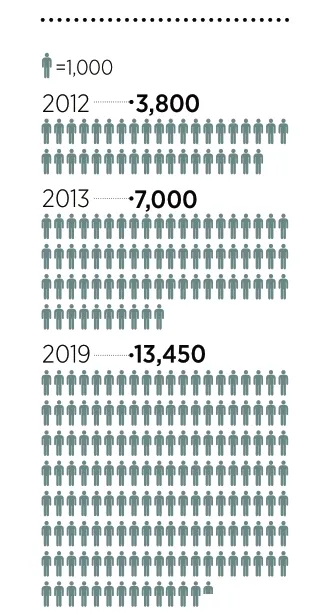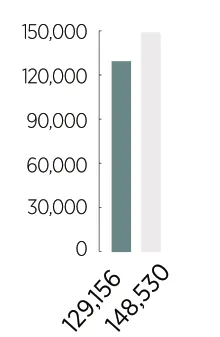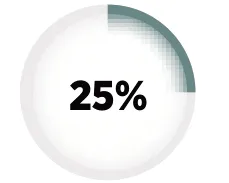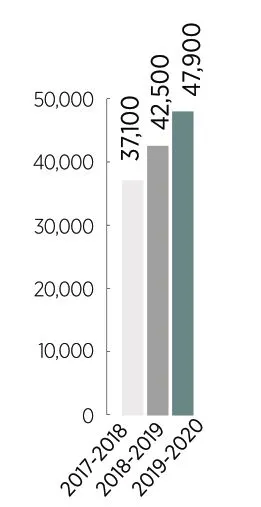SHIFTING To ASEAN UNIVERSITIES
2022-02-21ByZhangYanLianZhixian
By Zhang Yan, Lian Zhixian
Since the COVID-19 outbreak, more Chinese students have been choosing to study in ASEAN countries
After a lengthy deciding period, Li Fan, a senior student of Southwest Petroleum University,finally chose to apply to universities in Singapore after learning that a Chinese student had recently been fatally shot in Chicago.
“My sister studies in Singapore, and she told me that the country is safer and more friendly, making it more welcoming to international students,” said Li Fan.Despite the Omicron variant wave,many universities in the U.S.and other Western countries still require students to attend in-person classes.In contrast, many universities in Southeast Asian countries such as Thailand, Malaysia, and Singapore offer international students the option to take online classes to guarantee safety, which has been winning over Chinese students seeking to study abroad.

The University of Malaya.
The relatively low cost of education in ASEAN countries is another factor attracting Chinese students.
Booming Interest in ASEAN Universities
Increased uncertainties caused by the coronavirus crisis is making many Chinese students rethink where they study abroad.The pandemic puts a strain on the diplomatic relations between China and some Western countries, and a wave of anti-Asian hate incidents in the West has pushed many Chinese students to look to more friendly Asian countries for higher education.Compared to last year,applications to Curtin Singapore increased by 55 percent, while undergraduate applications to University of Malaya grew by 33 percent and postgraduate applications by 130 percent.According to a Quacquarelli Symonds report, more Chinese students are expected to choose to study in Asian countries,with Malaysia, Singapore, and the Philippines as the most popular destinations.
Before the COVID-19 pandemic, international students in ASEAN countries were already increasing.With the promotion of the Belt and Road Initiative and rapid economic development, ASEAN countries were attracting more and more Chinese students with high-quality education, low costs, a friendly environment,and similar cultures.By 2015,the number of China-ASEAN exchange students totaled over 190,000, among which around 120,000 were Chinese students,mostly studying in Singapore,Thailand, Indonesia, and Vietnam.
In 2013, the number of Chinese students studying in Malaysia doubled from 3,800 in 2012 to 7,000.In 2019, around 13,450 Chinese students studied in Malaysia, an increase of 254 percent compared with 2012.Thailand also saw an increase in Chinese students receiving further education in Thailand.According to a Reuters report,8,455 Chinese students were enrolled into Thai colleges and universities in 2017, a growth of 100 percent compared with 2012.
Last November 5, the 2021 International Education Summit Forum organized by China’s Industrial Bank released its 2021 Report on Chinese Students’ Overseas Studies.According to the report,in the recent three years, the proportion of Chinese students interested in studying in Singapore has increased from 9 percent to 12 percent.
Education quality in ASEAN countries is also undergoing rapid improvement.According to the newly released QS World University Rankings 2022,seven Indonesian universities rank in the top 1,000 worldwide,whereas a decade ago, the figure was zero.Three universities in ASEAN countries are listed in the top 100: National University of Singapore, Nanyang Technological University, and University of Malaya, which rank 11th, 12nd, and 65th respectively.
The relatively low cost of education in ASEAN countries is another factor attracting Chinese students.Statistics show that a Chinese student in Thailand spends two years and US$31,000 on average to get a masters degree, and the cost in Malaysia is only US$24,000 per year, compared to the US$50,000 it costs to study in the U.K.for one year and US$100,000 in the U.S.
55%
33%
13o%
Compared to last year, applications to Curtin Singapore increased by55 percent, while undergraduate applications to University of Malaya grew by33 percentand postgraduate applications by130 percent.

245%
In 2013, the number of Chinese students studying in Malaysia doubled from3,800in 2012 to7,000.In 2019,around13,450Chinese students studied in Malaysia,an increase of254 percentcompared with 2012.

At the 24th China International Education Exhibition Tour held in Beijing on March 23,2019, parents listen to a pitch from a booth promoting studying in Hong Kong.(VCG)

At the 24th China International Education Exhibition Tour held in Beijing on March 23,2019, visitors listen to a pitch from a booth promoting studying in the U.K. (VCG)
“I would have to spend about US$785 a month to rent a small apartment in Hong Kong, but in Malaysia US$314 a month will get you a big house in a community with a swimming pool and a gym,” said Li Yue,a Chinese student studying in the University of Malaya.“The lifestyle in Malaysia is much more affordable and comfortable.”
Waning Interest in U.S.Education
The U.S.is seeing a decline of enrollment of Chinese students compared with the increasing popularity of ASEAN universities.According to the Annual Report on the Development of Chinese Students Studying Abroad (2020-2021)released by the Center for China and Globalization, a Chinese non-governmental think tank,though the total number of Chinese students studying in the U.S.increased over the last 15 years, the growth rate declined from 29.9 percent(2009-2010) to 0.8 percent(2019-2020).

The Open Doors 2021 report by the Institute of International Education (IIE)showed that from 2020 to 2021,the number of students from the Chinese mainland studying in the U.S.dropped by14.8 percentto317,299.U.S enrollment of undergraduates and postgraduate students from the Chinese mainland also decreased to 125,616and 118,859respectively, a year-on-year drop of15.2 percentand13.3 percentrespectively.

The2021 Report on Chinese Students’Overseas Studyshowed that from 2019 to 2020, a total of148,530students from the Chinese mainland studied in the U.K.,a year-on-year increase of 15 percent.

Chinese students account for25 percentof international students, and Chinese youth’s interest in studying in the U.K.keeps growing.
The Open Doors 2021 report by the Institute of International Education (IIE)showed that from 2020 to 2021, the number of students from the Chinese mainland studying in the U.S.dropped by 14.8 percent to 317,299.U.S enrollment of undergraduates and postgraduate students from the Chinese mainland also decreased to 125,616 and 118,859 respectively, a year-on-year drop of 15.2 percent and 13.3 percent respectively.
Statistics from the U.S.Department of State showed that after the U.S.announced its visa restrictions in 2017, visa issuance to Chinese students decreased by 24 percent.In July 2021, over 500 Chinese students seeking doctors or masters degrees were denied student visas to the U.S.Most were majoring in sciences or engineering like computing,chemistry, and biomedicine in universities of science and technology.
For much of 2020, the U.S.was the most severely affected country by the COVID-19 outbreak.In November 2020,the average number of new confirmed cases in a single day in the United States exceeded 100,000.As of December 12,2021, the number of deaths related to the virus in the U.S.exceeded 800,000.According to Reuters, it took 111 days for the number of deaths in the United States to go from 600,000 to 700,000 and only 73 days to reach 800,000.The severe situation made Chinese students reconsider plans to go to the U.S.or switch to another country or region.
While Chinese students in the United States had felt a less friendly atmosphere as China-US relations deteriorated, the situation became much worse after the outbreak of COVID-19.Hate Crime Statistics released by the Federal Bureau of Investigation (FBI) showed that hate crime incidents in 2020 increased by 12.9 percent to 8,263, a record high over the past 12 years, and that 61.8 percent of the incidents were because of the offenders’ bias toward race, ethnicity or ancestry.The number of anti-Asian incidents reported in 2020 increased by 70 percent over 2019.

Statistics on higher education of the U.K.published by Higher Education Statistics Agency(HESA) show that from the 2015-2016 academic year to the 2019-2020 academic year, the number of Chinese students studying in the UK rose from90,735to141,870,an increase of56 percent.

According to statistics from the Hong Kong Committee on Self-financing Post-secondary Education, the total number of non-local students studying in Hong Kong universities in 2017-2018, 2018-2019, and 2019-2020 academic years were37,100,42,500, and47,900respectively,a continuous increase.
“I have heard of a couple of harassment incidents targeting Chinese students,” said Li Fan.“And then the Chicago shootings in November made me decide to look at other countries.” Safety has become a common concern for Chinese students seeking to study overseas.
“Schools that provide both online and offline classes are more popular among students, whereas schools requiring international students to come to school for inperson classes can lose popularity.”
Popularity of U.K.and Hong Kong SAR
In contrast, the United Kingdom, another popular destination for international students, has won the favor of more Chinese applicants and surpassed the United States as the most popular destination for two consecutive years.The 2021 Report on Chinese Students’Overseas Study showed that from 2019 to 2020, a total of 148,530 students from the Chinese mainland studied in the U.K., a year-on-year increase of 15 percent.Chinese students account for 25 percent of international students,and Chinese youth’s interest in studying in the U.K.keeps growing.
Statistics on higher education of the U.K.published by Higher Education Statistics Agency (HESA) show that from the 2015-2016 academic year to the 2019-2020 academic year,the number of Chinese students studying in the UK rose from 90,735 to 141,870, an increase of 56 percent.Interest in pusuing education in the U.K.kept rising even after the COVID-19 pandemic.
At present, the U.K.has basically resumed in-person teaching.Zhu Liang, a staffmember of Valeon, a Chinese agency for studying overseas,said that schools’ handling of the pandemic could make a great impact on students’choice of colleges.“Schools that provide both online and offline classes are more popular among students, whereas schools requiring international students to come to school for in-person classes can lose popularity,” Zhu added.Some overseas students want to have a sense of studying abroad, while those who do not want to risk coronavirus infections prefer to have classes online.
Another destination for higher education is Hong Kong SAR.While Hong Kong is gaining popularity again,the increase of students going to Hong Kong is not as stable as the U.K.Hong Kong began gaining momentum in attracting students from Chinese mainland in 2011.According to the statistics from EIC Education, a Chinese provider of overseas education services, the total number of applicants was around 300 in2011, 500 in 2012, and over 600 in 2013.Although the number of applicants is rising, the admission rate decreased year by year from 92 percent to 81 percent.
Since 2014, interest in studying in Hong Kong has shown a gradual decline.The 2015-2016 Report on Trends of Studying in Hong Kong showed that the number of applications to study in Hong Kong submitted through agencies providing overseas education services has dropped by nearly 30 percent compared with the previous year.Nine out of ten were postgraduate applications,but the admission rate was only 30 percent.With the gradual improvement of the social and economic environment in Hong Kong, interest in studying in Hong Kong slowly picked up until the outbreak of the pandemic.
According to statistics from the Hong Kong Committee on Self-financing Post-secondary Education, the total number of non-local students studying in Hong Kong universities in 2017-2018, 2018-2019, and 2019-2020 academic years were 37,100,42,500, and 47,900 respectively,a continuous increase.Zhu Liang explained that last year,students were still relatively optimistic about the situation after the COVID-19 pandemic.But a year later, many Chinese students gave up the idea of studying in other countries and turned to Hong Kong for further education.Consequently, many Hong Kong universities raised their admissions requirements this year.“For schools in Hong Kong, increased competition has made it easier for them to become more picky, especially after the outbreak in 2020,” said Zhu Liang.“And this is probably a good thing for them.”
